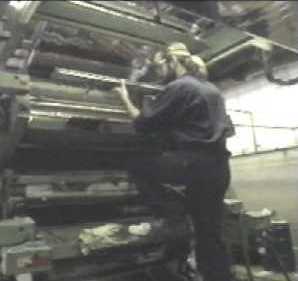Doctor Blade on:
[Wikipedia]
[Google]
[Amazon]
 In printing the doctor blade (from ''ductor blade'') removes the excess ink from the smooth non-engraved portions of the
In printing the doctor blade (from ''ductor blade'') removes the excess ink from the smooth non-engraved portions of the
 In printing the doctor blade (from ''ductor blade'') removes the excess ink from the smooth non-engraved portions of the
In printing the doctor blade (from ''ductor blade'') removes the excess ink from the smooth non-engraved portions of the anilox roll
In printing, anilox is a method used to provide a measured amount of ink to a flexographic (flexo) printing plate. An anilox roll is a hard cylinder, usually constructed of a steel or aluminum core which is coated by an industrial ceramic, typic ...
and the land areas of the cell walls. Doctor blades are also used in other printing
Printing is a process for mass reproducing text and images using a master form or template. The earliest non-paper products involving printing include cylinder seals and objects such as the Cyrus Cylinder and the Cylinders of Nabonidus. The ea ...
and coating
A coating is a covering that is applied to the surface of an object, usually referred to as the Substrate (materials science), substrate. The purpose of applying the coating may be decorative, functional, or both. Coatings may be applied as liquid ...
processes, such as flexo
Flexography (often abbreviated to flexo) is a form of printing process which utilizes a flexible relief plate. It is essentially a modern version of letterpress, evolved with high speed rotary functionality, which can be used for printing on a ...
and pad printing
Pad printing (also called tampography) is a printing process that can transfer a 2-D image onto a 3-D object (e.g. a ceramic pottery). This is accomplished using an indirect offset (gravure) printing process that involves an image being transfe ...
for the same function. It is believed that the name derives from the blades used in flatbed letterpress
Letterpress printing is a technique of relief printing. Using a printing press, the process allows many copies to be produced by repeated direct impression of an inked, raised surface against sheets or a continuous roll of paper. A worker comp ...
equipment for blades used to wipe ductor rolls, and "ductor" became doctor.
Design
In a single blade ink system or dual blade ink system, the blade removes the excess ink from the cylinder or anilox roll to create a uniform layer of ink to be transferred to the printing plate. The blade/anilox combination is designed such that it is (chiefly) the blade which wears away, not the anilox roll. The doctor blade is a relatively cheap and disposable consumable, while the gravure cylinder or flexoanilox
In printing, anilox is a method used to provide a measured amount of ink to a flexographic (flexo) printing plate. An anilox roll is a hard cylinder, usually constructed of a steel or aluminum core which is coated by an industrial ceramic, typic ...
is a more expensive component of the press. Typical materials for the blade are steel or polymer: gravure cylinders are normally hard-chrome plated and flexo aniloxes may be chromed or ceramic.
Important process variables in gravure
Rotogravure (or gravure for short) is a type of intaglio printing process, which involves engraving the image onto an image carrier. In gravure printing, the image is engraved onto a cylinder because, like offset printing and flexography, it ...
coating & printing are the rotational position at which the blade wipes the cylinder, the angle that the blade makes with the tangent to the cylinder at the contact point, and the pressure applied to the blade. Fine adjustment of in-and-out position, independently on left and right, must also be possible, in order to compensate for any misalignment between blade geometry and cylinder axis. These requirements are fulfilled by a doctor blade assembly which includes a doctor blade holder.
Doctor blades are traditionally designed in 3 main tip configurations: straight, bevel and lamella. A straight doctor blade has a straight, blunt edge and is used for lower quality print. A beveled doctor blade is cut at an angle creating a beveled edge. A lamella tip is a doctor blade with a unique geometry that is thin at the tip, gradually becoming larger in a step pattern or other design. The bevel and lamella designs allow for a smaller blade-to-anilox contact roll which increases its ability to precisely shear the anilox roll or gravure cylinder.
Oscillation
In order to keep the wear pattern as even as possible, and to help prevent any particles in the angle between blade and cylinder, all except the smallest machines use oscillating doctor blades. The entire doctor blade assembly oscillates from side to side.Printed Organic and Molecular Electronics edited by Daniel Gamota p286 The oscillation, flexibility of the blade, and the various possible misalignments and problems due to a lack of stiffness may result in the failure to achieve the desired angle of contact between the blade and the cylinder, or at least a failure to consistently achieve this desired angle.Replacement
Of necessity, the doctor blade must be easy and quick to replace. On many machines, the doctor blade holder is easily removable from the machine and the replacement of a doctor blade is done by removing the blade holder from the machine; discarding the old blade; inserting the new blade; and then replacing the blade holder and new blade in the machine. Most professionals prefer to use a removal tool such as a doctor blade puller for safety.See also
*Squeegee
A squeegee or squilgee is a tool with a flat, smooth rubber blade, used to remove or control the flow of liquid on a flat surface. It is used for cleaning and in printing.
The earliest written references to squeegees date from the mid-19th cent ...
References
{{reflist Relief printing